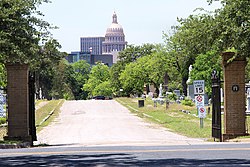Oakwood Cemetery (Austin, Texas)
Oakwood Cemetery NRHP: City Cemetery | |
U.S. National Register of Historic Places | |
 Comal St. entrance to the cemetery in 2018 | |
| Location | 16th & Navasota Austin, Texas, USA |
|---|---|
| Coordinates | 30°16′36″N 97°43′27″W / 30.27667°N 97.72417°W / 30.27667; -97.72417Coordinates: 30°16′36″N 97°43′27″W / 30.27667°N 97.72417°W / 30.27667; -97.72417 |
| MPS | East Austin MRA |
| NRHP reference # | 85002297[1] |
| Added to NRHP | September 17, 1985 |
Oakwood Cemetery, originally called City Cemetery, is the oldest city-owned cemetery in Austin, Texas. Situated on a hill just east of I-35 that overlooks downtown Austin, just north of the Swedish Hill Historic District and south of Disch-Falk Field, the once-isolated site is now in the center of the city.
Contents
1 History
2 Notable burials
3 References
4 External links
History
The cemetery dates from the mid-1850s. It may have begun even earlier, as legend states that its first tenants were victims of a Comanche attack whose bodies were laid to rest on the same hill.
The cemetery was renamed Oakwood in 1907 per city ordinance. It spreads over 40 acres (160,000 m2), including an annex across Comal Street to the east, and includes sections historically dedicated to the city's black, Latino, and Jewish populations. Paupers were historically buried in unmarked graves on the cemetery's south side. Graves without permanent markers were subject to reburial after a given period.
In 1914 the Oakwood Cemetery Mortuary Chapel was built on a design by Texas architect Charles Henry Page as a site for memorial services. The chapel was later renovated and remodeled in 1944 under the direction of local architect J. Roy White.[2]
The cemetery became a Recorded Texas Historic Landmark in 1972 and was added to the National Register of Historic Places in 1985; its annex was added on October 30, 2003. The view of the Texas State Capitol from Comal Street in the center of the cemetery became one of the Capitol View Corridors protected under state and local law from obstruction by tall buildings in 1983.[3] Despite its protected status, the cemetery has been subject to crime, vandalism, and decay for decades.
Notable burials
Wilmer Allison (1904–1977) - Tennis Player
John Barclay Armstrong (1850–1913) - Texas Ranger, U.S. Marshall, and rancher. Captured the notorious killer John Wesley Hardin and is enshrined in the Texas Ranger Hall of Fame in Waco.
Thomas N. Barnes (1930 – 2003) Fourth Chief Master Sergeant of the Air Force
Richard Bache, Jr. who represented Galveston in the Senate of the Second Texas Legislature in 1847 and assisted in drawing up the Texas Constitution of 1845. He was also the grandson of Benjamin Franklin, one of the Founding Fathers of the United States of America, and Deborah Read.
Albert S. Burleson (1863–1937) - United States Postmaster General (1913–1921)
Oscar Branch Colquitt (1861–1940) - Governor of Texas (1911–1915)- Jacob Carl DeGress (1842–1894) - First State Superintendent of Schools (1871) and Mayor of Austin (1877–1880)
Susanna Dickinson (1814–1883) - Alamo survivor
John Henry Faulk (1913–1990) - Radio Personality
Rebecca Jane G. Fisher (1831–1926), the only woman elected to the Texas Veterans Association and its last surviving member, the first woman to have her portrait hung in the Senate Chamber at the Texas Capitol.
Thomas Green (1814–1864) - American Civil War General
Andrew J. Hamilton (1815–1875) - Governor of Texas (1865–1866)
Morgan C. Hamilton (1809–1893) - U.S. Senator (1870–1877)- Peter Heinrich Oberwetter (1830–1915) - Botanist, Landscape artist for the Texas State Capital
John Hancock (1824–1893) - Member of the United States House of Representatives (1871–1885)
Ima Hogg (1882–1975) - Philanthropist
James S. Hogg (1851–1906) - Governor of Texas (1891–1895)
George W. Littlefield (1842–1920) - Cattleman, Banker, University of Texas Regent
Seth W. Mabry (1831–1914) - Cattleman
Henry Green Madison (1843–1912) - First African-American City Councilman of Austin, Texas
Elisha M. Pease (1812–1883) - Governor of Texas (1853—1857, 1867–1869)- Porter, Infant of W.S Porter; (1888) - Son of writer, O. Henry
- John Rabb (1798–1861) - One of the Original 297 Texas Settlers with the Stephen F. Austin Colony [4]
Oran M. Roberts (1815–1898) - Governor of Texas (1879–1883)
Ben Thompson (1842–1884) - City Marshal of Austin, Texas
William M. Walton (1832–1915) - Attorney General of Texas (1866–1867)
Charles S. West (1829–1885) - Texas Supreme Court justice and Secretary of State of Texas
- Dr. Annie Webb Blanton (1870–1945) - First woman elected to statewide office in Texas. Served as State Superintendent for Public Instruction from 1919-1922.
References
^ "NRHP nomination form" (PDF). Texas Historical Commission..mw-parser-output cite.citation{font-style:inherit}.mw-parser-output .citation q{quotes:"""""""'""'"}.mw-parser-output .citation .cs1-lock-free a{background:url("//upload.wikimedia.org/wikipedia/commons/thumb/6/65/Lock-green.svg/9px-Lock-green.svg.png")no-repeat;background-position:right .1em center}.mw-parser-output .citation .cs1-lock-limited a,.mw-parser-output .citation .cs1-lock-registration a{background:url("//upload.wikimedia.org/wikipedia/commons/thumb/d/d6/Lock-gray-alt-2.svg/9px-Lock-gray-alt-2.svg.png")no-repeat;background-position:right .1em center}.mw-parser-output .citation .cs1-lock-subscription a{background:url("//upload.wikimedia.org/wikipedia/commons/thumb/a/aa/Lock-red-alt-2.svg/9px-Lock-red-alt-2.svg.png")no-repeat;background-position:right .1em center}.mw-parser-output .cs1-subscription,.mw-parser-output .cs1-registration{color:#555}.mw-parser-output .cs1-subscription span,.mw-parser-output .cs1-registration span{border-bottom:1px dotted;cursor:help}.mw-parser-output .cs1-ws-icon a{background:url("//upload.wikimedia.org/wikipedia/commons/thumb/4/4c/Wikisource-logo.svg/12px-Wikisource-logo.svg.png")no-repeat;background-position:right .1em center}.mw-parser-output code.cs1-code{color:inherit;background:inherit;border:inherit;padding:inherit}.mw-parser-output .cs1-hidden-error{display:none;font-size:100%}.mw-parser-output .cs1-visible-error{font-size:100%}.mw-parser-output .cs1-maint{display:none;color:#33aa33;margin-left:0.3em}.mw-parser-output .cs1-subscription,.mw-parser-output .cs1-registration,.mw-parser-output .cs1-format{font-size:95%}.mw-parser-output .cs1-kern-left,.mw-parser-output .cs1-kern-wl-left{padding-left:0.2em}.mw-parser-output .cs1-kern-right,.mw-parser-output .cs1-kern-wl-right{padding-right:0.2em}
^ "City of Austin Cemeteries - Introducing the Master Plan Process" (PPT). City of Austin. Retrieved July 19, 2017.
^ "Downtown Development and Capitol View Corridors" (PDF). Downtown Austin Commission. June 27, 2007. Retrieved November 10, 2017.
^ John Rabb (1798 - 1861)
Find a Grave https://www.findagrave.com/cgi-bin/fg.cgi?page=gr&GRid=66837615
External links
- Austin Chronicle - "City of the Dead"
Oakwood Cemetery (Austin, TX) at Find A Grave
- Austin History Center, Oakwood Cemetery Database